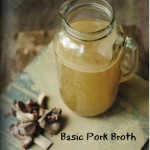 Making homemade bone broth is a crucial technique a Traditional Cook must master. Ideally, it is made at least once a week. Since quality bones are expensive, is pork broth an option? Most people have never considered it. Quality pastured pork at affordable prices is widely available in many communities. Let’s examine this question below.
Making homemade bone broth is a crucial technique a Traditional Cook must master. Ideally, it is made at least once a week. Since quality bones are expensive, is pork broth an option? Most people have never considered it. Quality pastured pork at affordable prices is widely available in many communities. Let’s examine this question below.
Health Requires Lots of Bone Broth – Why Not Pork?
I make a large pot of stock once or twice every week. Our family flies through quarts of it so quickly at mealtimes! A ready supply of gelatin and mineral rich broth in the freezer is also important when illness strikes. This nutrient rich food is a key player for rapid recovery without meds. This is especially true when a fever is involved.
Commercial Broth vs Homemade Broth
Getting sick and realizing there is no homemade bone broth is a devastating feeling, I can assure you! Simply running out to the store to pick up some canned soup or broth in a carton is not going to solve the problem. These industrially produced products even if organic are just water and MSG with little to no nutrient value and certainly no gelatin!
Even the properly made commercial bone broths available in recent years are not comparable to homemade. They are all watered down (every single brand I’ve tested). What’s worse, they are usually packaged in toxic plastic or plastic lined tetrapaks. The broth is boiling hot when it is poured into the containers if the product is shelf stable. Try it yourself. Put them in the refrigerator. They don’t gel like broth made at home does. The only brand worth buying is Epic bone broth in glass jars, but unfortunately it is still watered down.
Making your own broth has no substitute!
There is nothing worse than a tummy bug striking your children and knowing that a pot of gelatin rich stock that will halt the illness in its tracks is a full 24-48 hours away. Unless, of course, you can quickly source the right kind of fishheads, then a pot of stock can be ready in as little as 4 hours.
Pork Broth More Affordable than Most
With plenty of stock on hand for whatever your cooking or wellness needs might be, the next question is how to source quality bones at a price that is within a typical family’s food budget.
The highest quality pastured pork bones for making pork stock tend to cost between one half and three quarters as much as grassfed beef bones or pastured chicken in my experience, particularly if you source an entire hog.
Some might question how pork bones could make good pork broth given the fattiness of the meat. Culinary purists believe that soups and sauces made with fatty stock do not yield the best results. This problem is easily remedied by chilling pork stock in the refrigerator which allows the congealed pork fat to be removed from the top of the container of stock with a spoon.
If you’ve never tried pork broth or pork stock before, why don’t you give it a try? Here is a very simple and basic pork broth recipe to get you going. It is inspired by the beautiful book Beyond Bacon, Paleo Recipes that Respect the Whole Hog, by Stacy Toth and Matthew McCarry.
How to Make Pork Broth (Pork Stock)
The recipe for pork stock below makes about 2 quarts. Try it with your next batch! I’m sure you’re going to love it!


Pork Broth Recipe
How to make pork broth that is a affordable, nutritious, and delicious alternative to other more expensive stocks made with pastured poultry or grassfed beef bones.
Ingredients
- 3 lbs pastured pork bones
- 1 Tbl apple cider vinegar raw and unfiltered, preferably organic
- ground peppercorns
- sea salt
Instructions
-
Put all of the bones in a stockpot and add enough filtered water to cover.
Cook on high until the water comes to a boil and scum rises to the top. Cook for 5 minutes.
Dump the entire pot of water and refill with fresh filtered water, enough to cover the bones. Mix in the apple cider vinegar and bring the water to a boil once again.
Carefully skim off any foam that comes to the top. It should be minimal given that the water with most of the scum was dumped in the previous step.
Reduce heat and simmer on low for 9-24 hours.
Remove the pot from the heat, strain and taste. Add salt and pepper as needed. Let cool and then refrigerate in one or more airtight containers.
Skim the lard off the top of the chilled pork broth the following day and refrigerate. Reserve this delicious fat high in Vitamin D for cooking. This article plus video provides more information on how to render lard.
Use the clarified pork stock as the base for soups and sauces the same as you would use chicken or beef stock.
Sarah, The Healthy Home Economist








I understand skimming off the top foam, but why is it necessary to discard the first cooking liquid and start over? I feel like this contributes to a great loss of nutrients and flavor by throwing it away.
The pork broth tastes much better this way. You can skip this step if you like, but it is recommended to do so. Not much nutrition is lost as the meat is not cooked this quickly.
I typically do my beef bones for 24-48 hrs. But i heard that anything over 8-10 hrs causes the fat to heavily oxidize and therefore no longer a healthy fat to consume. So I use the fat cap to extend the life of the broth in the fridge but typically remove it when needed and don’t consume that fat. Any thoughts on this?
Just finished a big bowl of red lentil soup cooked with a quart of fresh pork bone stock made the day before, Great for a cold, wintery day here outside Chicago. The other two quarts are in the freezer, waiting for their turn to be used.
We use the stock for most any soup or liquid savory dish. Especially good in chili con carne.
I have been looking for recipes that USE pork broth and don’t find any. the recipes the show up use pork meat but use beef broth or chicken broth. I know I could just sub pork broth but was hoping for something specifically using pork broth.
Sarah, I’ve found that good bone broths make colonoscopy prep so much easier. The canned stuff is disgusting.
You know ppl don’t understand about bone broth..for when you get sick..i have some in my freezer both chicken and pig broth.. For when us and my family and sisters and brothers get sick i love it
Made my first Pork Bone Broth overnight and used your method along with some tips from an Bon Appetit article called “Bone Broth: You’re Doing it Wrong”. I sourced the bones from a butcher in Phoenix that raises and slaughters their own hogs (humane/hormone and antibiotic free). I did the initial boil/skim and then roasted the bones for an hour @ 450. I slow-simmered for 15 hours and it turned out perfectly. Thank you!
Thank you for your recipe This is the first time I have made bone marrow broth and your instructions walked me through every step
while visiting my pork farmer last weekend we slaughtered and butchered a pig and I was lucky enough to get home with half of it. I took the entire spine and ribs and made broth. While I’ve definitely enjoyed pork broth before I’ve never had access to an entire spine like this, and the initial results confused me a bit. Hoping you might have some insight, a quick google search didn’t yield a whole lot of info.
Rather than chill the broth and remove the fat at the end I do this in the final stages of boiling. I skim off the fat into a measuring cup and let it settle then skim the fat off again and pour any stray broth back in, so I don’t lose any of the goodness. Usually while making any kind of bone broth I get two very distinct layers but this time I’ve got three layers. The top is fat, the bottom broth, and the middle I’m not so sure about. It separates from the fat that I skim off the top, not from the broth.
Wondering what it is mostly and if I should be keeping this as part of my broth or discarding it.
Can I use pig tails as an alternative to chicken feet?